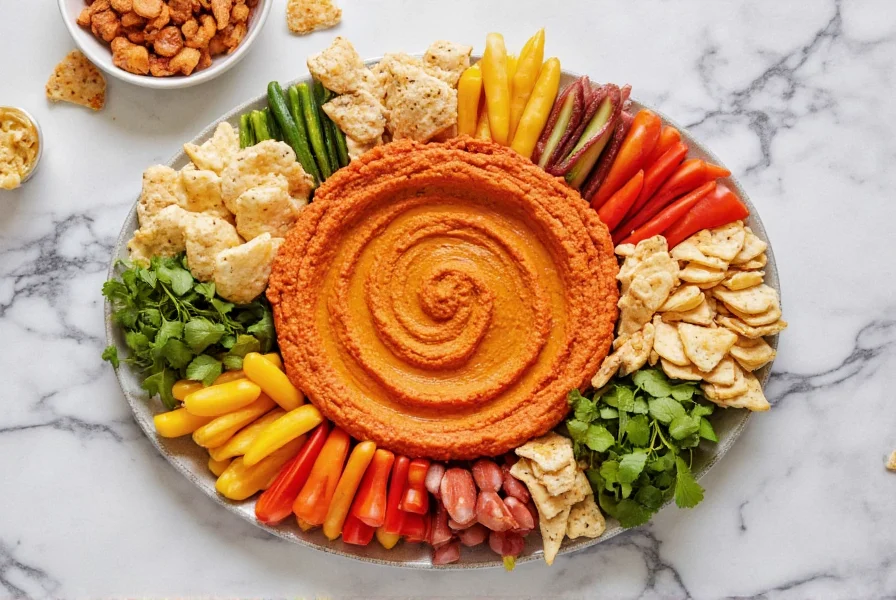Creating exceptional hummus with red peppers requires understanding the perfect balance between creamy chickpeas, rich tahini, and sweet roasted peppers. Unlike basic recipes that rely on canned chickpeas alone, this method incorporates a professional technique for ultra-smooth texture while highlighting the natural sweetness of roasted red peppers.
Essential Ingredients for Perfect Red Pepper Hummus
Quality ingredients make the difference between ordinary and extraordinary hummus. For authentic flavor and texture:
| Ingredient | Quantity | Professional Tip |
|---|---|---|
| Cooked chickpeas | 1½ cups (250g) | Use home-cooked with baking soda for creamier texture |
| Roasted red peppers | ½ cup (75g) | Pat dry to prevent watery hummus |
| Tahini paste | ⅓ cup (80ml) | Stir well before measuring |
| Fresh lemon juice | 3 tbsp (45ml) | Adjust to taste for brightness |
| Garlic | 1 clove | Use raw for traditional flavor |
| Ice water | 3-4 tbsp (45-60ml) | Add gradually while blending |
Step-by-Step Preparation Guide
Follow these professional techniques for restaurant-quality hummus at home:
- Prepare chickpeas: If using dried chickpeas, soak overnight then cook with ½ tsp baking soda until extremely tender (about 1 hour). Drain, reserving ¼ cup cooking liquid.
- Roast peppers: Char fresh red peppers over open flame or broil until blackened. Place in sealed bag for 10 minutes, then peel and remove seeds.
- Blend base: Process tahini and lemon juice in food processor for 1 minute until creamy.
- Incorporate ingredients: Add chickpeas, roasted peppers, garlic, cumin, and 2 tbsp ice water. Blend 4-5 minutes, scraping sides occasionally.
- Adjust consistency: With processor running, slowly add reserved chickpea liquid or additional ice water until silky smooth.
- Season: Add salt to taste and blend 30 seconds more.

Pro Tips for Superior Results
Elevate your easy roasted red pepper hummus recipe with these chef-recommended techniques:
- Peel chickpeas after cooking for ultra-smooth texture (tedious but worth it for special occasions)
- Use high-quality tahini with no added oils or preservatives for authentic flavor
- Chill ingredients before blending to maintain emulsion and prevent overheating
- Blend longer than you think necessary - 5 full minutes creates the creamiest texture
- Add paprika or smoked paprika for depth of flavor that complements the roasted peppers
Serving Suggestions and Pairings
This homemade hummus with roasted red peppers shines when served with:
- Freshly warmed pita bread cut into triangles
- Crisp vegetable sticks (carrots, cucumbers, bell peppers)
- Olive oil drizzle and sprinkle of sumac for tangy finish
- Toasted pine nuts for added crunch
- As a spread in sandwiches or wraps
Storage and Shelf Life
Properly stored, your creamy red pepper hummus will maintain freshness:
- Refrigerate in airtight container for up to 5 days
- Place plastic wrap directly on hummus surface to prevent drying
- Stir well before serving if separation occurs
- Do not freeze as texture becomes grainy upon thawing
Popular Variations to Try
Customize your traditional hummus recipe with roasted peppers with these delicious options:
- Spicy version: Add ½ tsp cayenne pepper or harissa paste
- Herb-infused: Blend in 2 tbsp fresh cilantro or parsley
- Extra garlicky: Roast 2-3 garlic cloves before adding
- Sun-dried tomato twist: Replace ¼ cup roasted peppers with oil-packed sun-dried tomatoes

Frequently Asked Questions
Why is my red pepper hummus watery?
Watery hummus usually results from excess liquid in roasted peppers or over-blending. Always pat roasted peppers thoroughly dry before adding, and add liquid gradually while blending. If already watery, refrigerate for 2 hours to thicken or add 1-2 tbsp additional chickpeas.
Can I use jarred roasted red peppers?
Yes, jarred roasted red peppers work well in a quick preparation of red pepper hummus. Drain thoroughly and pat completely dry with paper towels to remove excess moisture that would thin your hummus. For best flavor, choose peppers packed in water rather than oil.
How do I make hummus without tahini?
For a tahini-free version of this healthy roasted red pepper hummus, substitute with 3 tbsp Greek yogurt plus 1 tbsp sesame seeds. The texture will be slightly different but still delicious. Alternatively, use 2 tbsp natural peanut butter for a unique flavor profile that still complements the roasted peppers.
What makes this red pepper hummus extra smooth?
The secret to ultra-smooth texture in this best red pepper hummus for dipping is threefold: using baking soda when cooking chickpeas to break down skins, blending for a full 5 minutes, and incorporating ice water gradually while processing. The roasted peppers should be well-drained to prevent wateriness while maintaining creaminess.
Can I prepare this hummus ahead of time?
Absolutely! This traditional hummus recipe with roasted peppers actually improves in flavor after resting. Prepare up to 24 hours ahead, store with plastic wrap touching the surface, and refrigerate. The flavors meld beautifully overnight. Bring to room temperature 30 minutes before serving and stir well.











 浙公网安备
33010002000092号
浙公网安备
33010002000092号 浙B2-20120091-4
浙B2-20120091-4